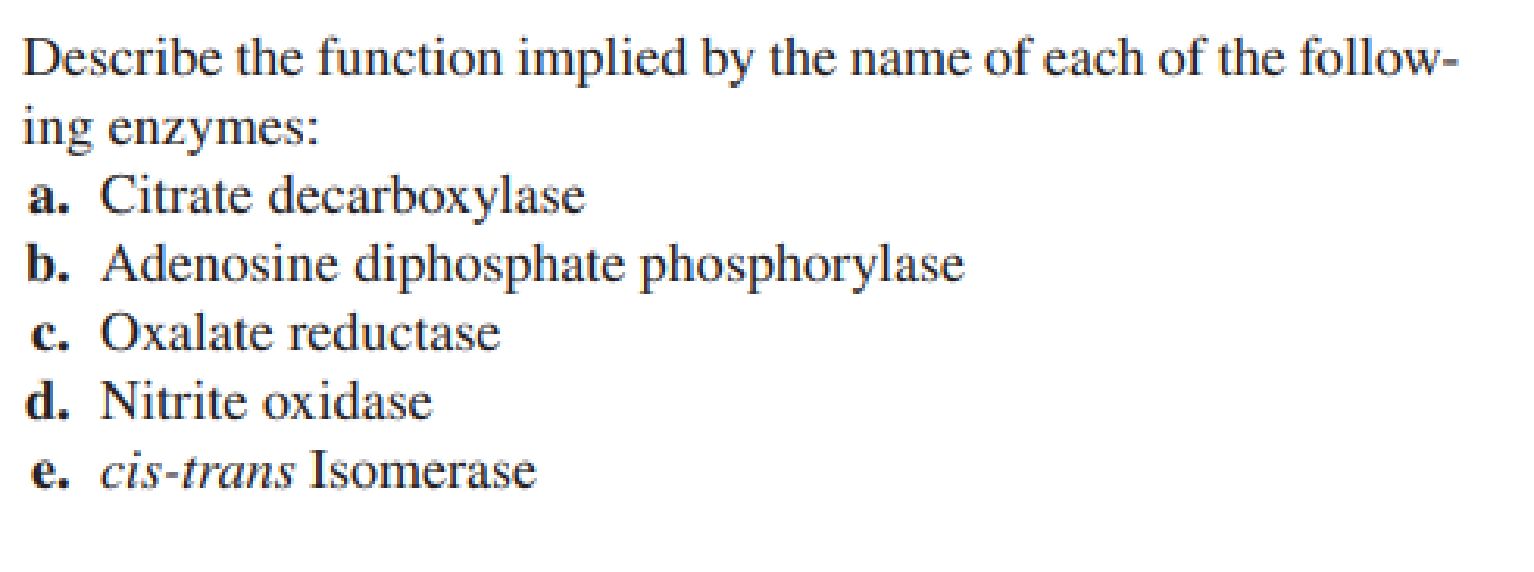
Concept explainers
(a)
Interpretation:

The function implied by the enzyme citrate decarboxylase has to be given.
Concept Introduction:
The enzymes are essentially the biocatalysts present in all living systems. Each enzyme catalyzes a characteristic reaction within the biological system. Enzymes on the basis of the substrate on which they act or the reaction that they catalyze can be classified into six classes.
Based on their specific role they are classified into six major classes. These are:
- Ligases: The enzymes that connect two molecules via covalent bonds are termed as ligases.
- Isomerases: The enzymes that catalyze the isomerization reactions are termed as isomerases.
- Lyases: Enzymes that catalyze the cleavage of bonds are called lyases.
- Hydrolases: These enzymes catalyze the cleavage of bonds via hydrolysis present in biological systems.
- Transferases: These enzymes are involved in the transfer of various
functional groups such as methyl, acetyl group, or phosphate group. - Oxidoreductases: As the name suggests, these catalyze the
oxidation and reduction reactions that occur in living systems.
Enzymes are often named in accordance with the substrate on which they act. For example, lactase acts on the disaccharide named lactose and helps to remove the glycosidic linkages of lactose.
(b)
Interpretation:
The function implied by the enzyme adenosine diphosphate phosphorylase has to be given.
Concept Introduction:
Refer to part (a).
(c)
Interpretation:
The function implied by enzyme oxalate reductase has to be given.
Concept Introduction:
Refer to part (a).
(d)
Interpretation:
The function implied by the enzyme nitrite oxidase has to be given.
Concept Introduction:
Refer to part (a).
(e)
Interpretation:
The function implied by the enzyme cis-trans isomerase has to be given.
Concept Introduction:
Refer to part (a).
Want to see the full answer?
Check out a sample textbook solution
Chapter 19 Solutions
GENERAL,ORGANIC,+BIOCHEMISTRY
- Show how to convert ethyl benzene to (a) 2,5-dichlorobenzoic acid and (b) 2,4-dichlorobenzoic acid.arrow_forwardno aiarrow_forwardPolymers may be composed of thousands of monomers. Draw three repeat units (trimer) of the polymer formed in this reaction. Assume there are hydrogen atoms there are hydrogen atoms on the two ends of the trimer. Ignore inorganic byproducts.arrow_forward
- 8:44 PM Sun Apr 13 Earn Freecash.com O Measurement and Matter =1 Setting up a unit conversion 110 Eddie says... ✰ www-awu.aleks.com A student sets up the following equation to convert a measurement. (The ? stands for a number the student is going to calculate.) Fill in the missing part of this equation. Note: your answer should be in the form of one or more fractions multiplied together. (- 4 J kJ -7.0 × 10 ☐ = ? mmol.°C mol °C x10 μ Explanation Check □·□ torox.io Grey Hill LLC. All Rightsarrow_forwardPolymers may be composed of thousands of monomers. Draw three repeat units (trimer) of the polymer formed in this reaction. Assume there are hydrogen atoms there are hydrogen atoms on the two ends of the trimer. Ignore inorganic byproducts please.arrow_forwardi need help with the folarrow_forward
 ChemistryChemistryISBN:9781305957404Author:Steven S. Zumdahl, Susan A. Zumdahl, Donald J. DeCostePublisher:Cengage Learning
ChemistryChemistryISBN:9781305957404Author:Steven S. Zumdahl, Susan A. Zumdahl, Donald J. DeCostePublisher:Cengage Learning ChemistryChemistryISBN:9781259911156Author:Raymond Chang Dr., Jason Overby ProfessorPublisher:McGraw-Hill Education
ChemistryChemistryISBN:9781259911156Author:Raymond Chang Dr., Jason Overby ProfessorPublisher:McGraw-Hill Education Principles of Instrumental AnalysisChemistryISBN:9781305577213Author:Douglas A. Skoog, F. James Holler, Stanley R. CrouchPublisher:Cengage Learning
Principles of Instrumental AnalysisChemistryISBN:9781305577213Author:Douglas A. Skoog, F. James Holler, Stanley R. CrouchPublisher:Cengage Learning Organic ChemistryChemistryISBN:9780078021558Author:Janice Gorzynski Smith Dr.Publisher:McGraw-Hill Education
Organic ChemistryChemistryISBN:9780078021558Author:Janice Gorzynski Smith Dr.Publisher:McGraw-Hill Education Chemistry: Principles and ReactionsChemistryISBN:9781305079373Author:William L. Masterton, Cecile N. HurleyPublisher:Cengage Learning
Chemistry: Principles and ReactionsChemistryISBN:9781305079373Author:William L. Masterton, Cecile N. HurleyPublisher:Cengage Learning Elementary Principles of Chemical Processes, Bind...ChemistryISBN:9781118431221Author:Richard M. Felder, Ronald W. Rousseau, Lisa G. BullardPublisher:WILEY
Elementary Principles of Chemical Processes, Bind...ChemistryISBN:9781118431221Author:Richard M. Felder, Ronald W. Rousseau, Lisa G. BullardPublisher:WILEY





